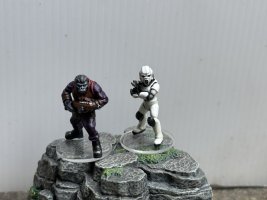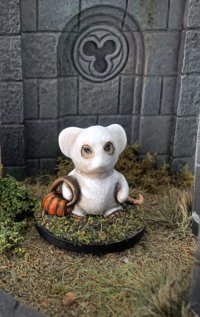Machen
Vassal
Hi folks,
I recently painted my first predominantly white-colored armored miniature (a metal Drone Trooper, the Star Schlock equivalent of a Storm Trooper) and discovered first hand how hard it can be to do without leaving noticeable brushstrokes and getting pasty. After finishing, I discovered first hand how hard it is to photograph a predominantly white colored miniature with an iphone, which kept washing it out.
Is there any advice you could give me on getting the best results when hand brushing white? (I still don't have an airbrush and would rather not invest time and money in one at the moment.) Are any specific paints particularly good? Is it mainly a matter of thinning the white paint and applying several coats, or is there more to it?
Here's the Drone Trooper in question alongside a Star Schlock Ape Trooper that I also painted recently (yep, their take on Planet of the Apes. 70's / 80's Sci-fi mash-ups are what Star Schlock is about.) I don't know if the image below will do a good job of showing the difficulties I'm having - just getting the image to appear here without being auto-adjusted by the forum to a starkly washed out white took some doing.

I recently painted my first predominantly white-colored armored miniature (a metal Drone Trooper, the Star Schlock equivalent of a Storm Trooper) and discovered first hand how hard it can be to do without leaving noticeable brushstrokes and getting pasty. After finishing, I discovered first hand how hard it is to photograph a predominantly white colored miniature with an iphone, which kept washing it out.
Is there any advice you could give me on getting the best results when hand brushing white? (I still don't have an airbrush and would rather not invest time and money in one at the moment.) Are any specific paints particularly good? Is it mainly a matter of thinning the white paint and applying several coats, or is there more to it?
Here's the Drone Trooper in question alongside a Star Schlock Ape Trooper that I also painted recently (yep, their take on Planet of the Apes. 70's / 80's Sci-fi mash-ups are what Star Schlock is about.) I don't know if the image below will do a good job of showing the difficulties I'm having - just getting the image to appear here without being auto-adjusted by the forum to a starkly washed out white took some doing.



